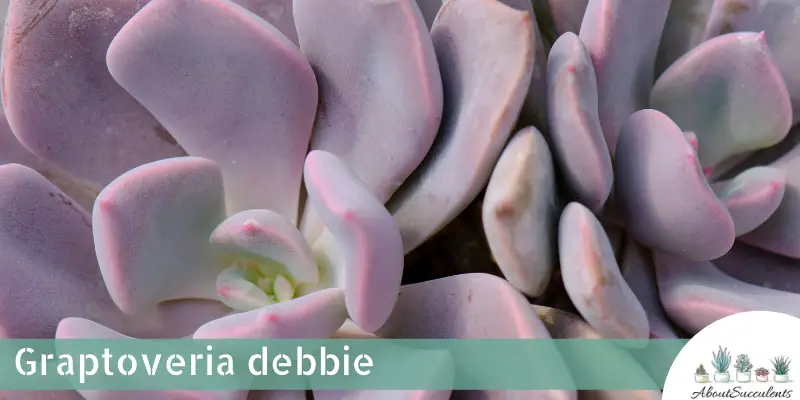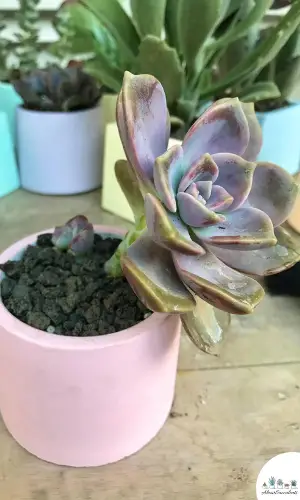
Graptoveria “Debbie” is a scintillating Echeveria succulent that’s characterized by its rose-shaped rosette with purplish-blue leaves. Grown outdoors, the leaves will have white-colored tips that when stressed, turn into an attractive pink.
Debbie also goes by other names such as Graptoveria Fred Ives, Fanfare, Moon Glow, and X Graptoveria.
When Graptoveria Debbie hits full maturity, it can reach a height of 20cm (8”) and produces small, orange flowers in the springtime. In some cases, Debbie blooms frosty pink flowers that turn into a brighter shade of pink when regularly exposed to the sun.
Graptoveria Debbie is from the Crassulaceae family and is a hybrid of the Echeveria succulent and Graptopetalum. It’s native to Central America and Mexico.
General Information:
Also known as: Debbie, Graptoveria Fred Ives, Fanfare, Moon Glow, and X Graptoveria
Plant Family: Crassulaceae
Origin: Central America, Mexico
Height: 20cm (8”)
Exposure: Partial or direct sun for up to 6 hours
Water Needs: Drought-resistant; only water when the soil is completely dry.
Soil Type: Standard potting mix with pit, grit, sand, and compost.
Soil pH: 6.5 to 6.8
How To Grow and Care for Graptoveria “Debbie”

Graptoveria Debbie is an easy succulent plant to grow and care for. To bring out Debbie’s beauty to the fullest, it would be best to grow it as an outdoor plant.
If you live in a region where the temperature drops below -6.7° C (20° F), it would be best to grow Debbie in a pot that can be moved indoors as this is not a cold-hardy succulent.
Sunlight
As a garden succulent, plant Debbie in an area that gets 6 hours of morning sunlight every day. In the afternoon, give Graptoveria some shade to protect it from the scorching rays of the sun.
If you want to grow Debbie as an indoor plant, the best location is near a window that receives morning sunlight. This is a type of succulent that thrives even with partial sunlight.
In regions where the temperature can drop to below freezing, place Graptoveria Debbie under a Grow Light for 3 to 6 hours per day.
Watering
Similar to other varieties of Echeveria succulent, Graptoveria Debbie is highly tolerant of drought. It can survive without water for a long period of time.
The best way to find out if Debbie needs water is by checking the moisture level of the soil. If it’s dry to the touch, you can water the soil. If you want to be more sure, insert a stick into the soil.
Pull out the stick and if its end feels dry, then it would be safe to water the soil until it’s soaked.
Do not overwater this type of succulent as the roots can rot. The watering schedule during the colder months is less frequent as the soil remains moist longer.
Pot and Soil
If you want to grow Graptoveria Debbie in a pot, choose one that’s made of either ceramic or terracotta and has a drain hole with a mesh net at the bottom. Ceramic or terracotta allow for moisture to escape along the side of the pot and this helps the soil dry out.
The best type of soil to plant Graptoveria Debbie in is a standard potting mix with added pit, grit, or sand and some compost to improve drainage.
How to Propagate Graptoveria Debbie
Horticulturists love Debbie because the succulent plant offers 4 ways to propagate the species: Stem and leaf cuttings, offsets, and seeds.
Method 1 – Stem Cuttings Method
Step 1: Look for a healthy stem from the main plant.
Step 2: Use a sterilized and sharp pair of garden shears or knife to remove the stem.
Step 3: Let the stem cuttings rest on a warm and dry area. Allow the cuttings 2 to 3 to develop hard calluses.
Step 4: Once the cuttings have callused, place them on a pot filled with standard soil mix.
Step 5: Only water the soil when it has completely dried out.
Method 2 – Leaf Cuttings Method
Step 1: Find a leaf from the stem that shows no sign of disease or fungi.
Step 2: You can do a clean pull and twist to remove the leaf from the stem or you can use a pair of sharpened and sterilized scissors. Make sure there are no parts of the leaf left on the stem to guarantee a successful propagation of the succulent.
Step 3: Place the leaf cuttings on a dry area and let them callus over a period of 3 days. Any longer than 3 days and the cuttings will run out of moisture.
Step 4: Fill up a pot with a standard potting mixture and place the leaf cuttings on top.
Step 5: Mist the leaf cuttings lightly if the soil has completely dried out.
Method 3 – Offsets Method
Step 1: Cut out the offsets that grow at the bottom of the plant with a pair of sterilized and sharpened garden shears.
Step 2: Allow the offsets to dry out and callus within 2 to 3 days.
Step 3: Place the callused offsets on a pot filled with well-draining soil and water whenever it’s dry to the touch.
Method 4 – Seed Method
Step 1: Plant the seeds in well-draining soil.
Step 2: Place the soil under a Grow Light or use a Seed Warmer.
Step 3: Water the soil only when it’s completely dry.
Frequently Asked Questions
Is Graptoveria Debbie Toxic to Cats and Dogs?
Graptoveria Debbie does not appear on the website of the American Society for the Prevention of Cruelty to Animals (ASPCA) list of plants that are toxic to cats and dogs.
Why Is My Graptoveria Debbie Dying?
There are 2 possible causes as to why your Graptoveria Debbie is dying: Overwatering and Pest Infestation.
Overwatering
Giving Debbie water when the soil has not dried out completely will result in the roots rotting and developing fungi. This can spread and infect the entire plant unless the contaminated parts are removed.
Use a sterilized and sharpened knife or garden shears to remove the infected parts of the succulent. Next, gently uproot it from the pot. Cut out the roots that have rotted and allow the plant to dry out.
Fill out a new pot with fresh soil and re-plant Graptoveria Debbie.
Pest Infestation
Mealybugs are attracted to Graptoveria Debbie because of its nutritious sap. If you see cotton-like substances on the leaves of the succulent plant, you have mealybugs as tenants.
You can remove the mealybugs by spraying Debbie with neem oil or by wiping the leaves with 70% isopropyl alcohol.
Does Graptoveria Debbie Produce Flowers?
Yes, Graptoveria Debbie blooms pink flowers in the springtime. Some Debbie flowers have different colors such as orange and yellow.
Last Updated on June 9, 2022 by Sofia Lara